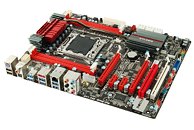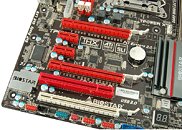Wednesday, November 2nd 2011

Biostar TPower Makes a Comeback with TPower X79, Geared for Extreme Overclocking
Biostar's coveted TPower brand makes a comeback with TPower X79, Biostar's premium overclocking motherboard for the Core i7 "Sandy Bridge-E" platform. TPower motherboards have been known to be a part of some record-setting CPU OC feats right from the days of LGA775. The TPower X79 is another product that's meant for record-setting feats, with its strong VRM and slim feature-set that does away with everything overclockers don't need and adds to the bloat of the motherboard.
The CPU is powered by an 8-phase DuraMax VRM with active phase control and direct FETs. It draws power from two 8-pin EPS connectors, apart from the 24-pin ATX and an optional 4-pin Molex for PCIe slot stability. Apart from a strong VRM, the board makes use of POSCAP capacitors in the CPU area, and a high-quality clock generator. The VRM and chipset heatsinks are connected with a 6 mm heat pipe, the heatsinks are made of a ceramic surface material for better dissipation. The CPU is wired to just four DDR3 DIMM slots, one per channel, which shouldn't be an issue for overclockers. It gives you shorter memory traces. Apart from JEDEC speeds of up to DDR3-1600 MHz, the board supports DDR3-2400 MHz by overclocking.Expansion slots include two PCI-Express 3.0 x16 (permanent x16), one PCI-Express 2.0 x16 (permanent x8, white), two PCIe x1, and a legacy PCI. Storage connectivity includes six SATA 6 Gb/s (two via X79 PCH, four via additional controllers), one (red) SATA 3 Gb/s from the PCH (for the optical drive), and an eSATA 3 Gb/s, also from the PCH. There are eight USB 3.0 ports on the board (six on the rear panel, two via header), all driven by 2-port controllers made by ASMedia. Other connectivity includes one gigabit Ethernet connection, and 8+2 channel HD audio. A nice cosmetic touch here is the EMI shield over the audio CODEC.
Source:
MyDrivers
The CPU is powered by an 8-phase DuraMax VRM with active phase control and direct FETs. It draws power from two 8-pin EPS connectors, apart from the 24-pin ATX and an optional 4-pin Molex for PCIe slot stability. Apart from a strong VRM, the board makes use of POSCAP capacitors in the CPU area, and a high-quality clock generator. The VRM and chipset heatsinks are connected with a 6 mm heat pipe, the heatsinks are made of a ceramic surface material for better dissipation. The CPU is wired to just four DDR3 DIMM slots, one per channel, which shouldn't be an issue for overclockers. It gives you shorter memory traces. Apart from JEDEC speeds of up to DDR3-1600 MHz, the board supports DDR3-2400 MHz by overclocking.Expansion slots include two PCI-Express 3.0 x16 (permanent x16), one PCI-Express 2.0 x16 (permanent x8, white), two PCIe x1, and a legacy PCI. Storage connectivity includes six SATA 6 Gb/s (two via X79 PCH, four via additional controllers), one (red) SATA 3 Gb/s from the PCH (for the optical drive), and an eSATA 3 Gb/s, also from the PCH. There are eight USB 3.0 ports on the board (six on the rear panel, two via header), all driven by 2-port controllers made by ASMedia. Other connectivity includes one gigabit Ethernet connection, and 8+2 channel HD audio. A nice cosmetic touch here is the EMI shield over the audio CODEC.




28 Comments on Biostar TPower Makes a Comeback with TPower X79, Geared for Extreme Overclocking
www.thinkgeek.com/caffeine/wacky-edibles/e5a7/
;)
Nice layout and features. The more boards the merrier.. competition!